
[C. frutescens and C. annuum]
This page deals directly with chilis used in Thailand, because Thai usage is so familiar here in Southern California, but the page has been expanded with information regarding other regions of mainland Southeast Asia.
Many kinds of chilis (Prik or Phrik) are grown in Thailand, and terminology, by time it's translated to English, is very confusing and sometimes just plain wrong. Much less information is available from other Southeast Asian countries. Details of size and hotness are difficult to find for those not available in California. Asian sources don't bother with these details because "everyone already knows". Several of the smallest chilis are called "Bird Peppers", but this name is not at all unique to Thailand. Here you will find my descriptions as best I could gather from a multitude of sources.
While all chilis, from the tiniest beads to the big bell peppers, originated in Central and South America, chilis are so variable that unique varieties have been developed in many countries for local use. While more than 75 varieties are grown in Thailand alone, I list here the most important.
Unfortunately, of the Thai chilis only prik ki nu is readily available in Los Angeles. Even in Thai Town (Hollywood Blvd east of Western) they have only prik ki nu, serranos, jalapenos and maybe Fresnos, so substitutions have to be made - unless you grow them yourself (seeds are readily available on-line).
More on Chili Peppers.
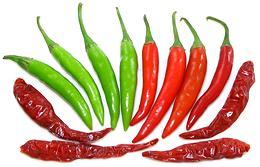 [Rat Turd Chili; Mak Pet Ki Nuu (Laos); Nga Yut Thee (Burma); Scuds
(some chefs); C. annuum]
[Rat Turd Chili; Mak Pet Ki Nuu (Laos); Nga Yut Thee (Burma); Scuds
(some chefs); C. annuum]
This is the chili we most think of as "Thai Chili", and the only one
commonly sold in North America. It is small, often less than 1-3/4 inches
long as grown in Thailand, but there are many varieties and those grown
in California are often up to 2-3/4 inches (more efficient to grow and
harvest large sizes). They are narrow, pointy and start growing point
up, but turn downward as they reach full size. They turn from green to
red when ripe (they may be somewhat orange in between). Red ripe they
are called prik ki nu daeng. They are very hot
(H8 to H9), slightly less hot when red
ripe, and a little less than that when dried. Fully red ripe prik ki nu
dry very well into fine dried red chilis, called prik ki nu daeng
haeng. Those imported from Thailand tend to be hotter than if you
dried those grown in California. Some minor varieties are black if in
full sun, turning bright orange when ripe.
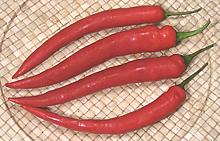 [Spur Chili; Mak Pet Nyai (Laos); C. annuum]
[Spur Chili; Mak Pet Nyai (Laos); C. annuum]
These are pointy like the prik ki nu, but are much larger, up to nearly
6 inches long, and not as hot. They also grow point up, in fact the name
means "pointing to the sky". In Thailand they are sold green, red and
dried, but I haven't seen them in Southern California.
Holland Red would probably be closest to
fresh red ones, though around here
Red Fresnos are the standard medium hot red chili used by
every ethnic group. The photo specimens are actually Holland Red, which
look exactly like photos of Prik Chee Fah I've seen taken in Thailand,
and they fit the description.
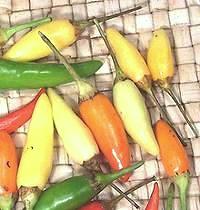 [Karen Chilis; C. frutescens]
[Karen Chilis; C. frutescens]
These are shorter than prik ki nu, proportionally wider and even hotter.
They are a classic "Bird Chili", very small, very hot
(H9) and growing point up. They may be
green, yellow, orange red or purple, and can sometimes be found from an
Asian grower in a farmer's market.
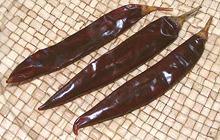 [C. annum]
[C. annum]
These chilis are used particularly in northern Thailand, and an important
roasted flake is made from them. They are not yet available in North
America, but expert opinion is that Mexican Puya chilis are a fine
substitute - about the same size, flavor and hotness
(H4-H5). The photo specimens are Puya,
about 4-1/2 inches long. They are available from some markets
serving a Mexican community. Easier to find Gujillas are a little larger
and a little less hot, but similar.
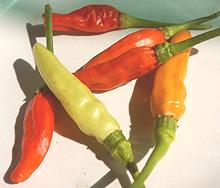 [Mac Pet (Laos); C. annum]
[Mac Pet (Laos); C. annum]
These are the most popular chilis in Laos, thus the name Mac Pet (Hot
Chili) with no modifier. They are plumper and longer (up to 3 inches)
than the Prik Ki Nu, and usually blunt at the end. They are also
significantly less hot (H5-H6).
They are sold at several stages of ripeness, green, yellow, orange and
red. Photo borrowed from Swedish seed seller
Jalapeno.nu, but they don't
have any for sale.
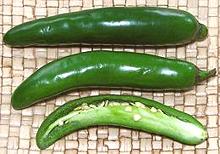
[C. annuum]
These are regular Serrano chilis, now grown in Thailand for use in table
condiments and hot sauces. They were Introduced to Thailand by visitors
and returnees from California. Before Thai chilis were much grown in
Southern California we used Serranos for Thai table condiments. Now some
restaurants have gone to a 4 cup condiment tray so guests can have both
Thai chilis and the more flavorful Serranos. I understand Sriracha sauce
is now being made in Thailand from red ripe Serranos. Serranos are thick
walled and do not dry well, so are always used fresh or pickled. Their
hotness is about H6, but somewhat
variable.
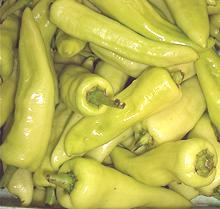 [Mac Pet Nyai (Lao); C. annuum]
[Mac Pet Nyai (Lao); C. annuum]
This is a fairly large, mild yellow-green to yellow chili, sometimes
called "Thai sweet pepper". While mild, it is not completely without
heat, but is used as a vegetable rather than as a seasoning. It is
similar to low heat Banana Peppers, which would make good substitutes.
Mild Hungarian peppers would also work, though they have a blockier
shape. Prik Yuak is used extensively in salads and stir fries, and is
also often stuffed.
Photo courtesy Susan Slater © .
 [Mac Pet Haeng (Laos)]
[Mac Pet Haeng (Laos)]
These small, very hot dried red chilis made from Prik Ki Nu, Prik
Kariang or similar. Thai recipes using them often end in "Prik Haeng".
Those in the photo I dried myself, as I do whenever one of the local
markets has a batch of really fine bright red Thai chilis. Very hot,
but not quite as hot as fresh chilis of the same type. They are easily
available imported from Thailand, and the imports are somewhat hotter
than the California grown.
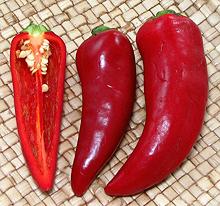 ["Red Jalapeno" (U.S. supermarkets); C. annuum]
["Red Jalapeno" (U.S. supermarkets); C. annuum]
This is not a Thai chili (at least not yet), but it has been
chosen by all ethnicities in Southern California as the medium hot red
chili suitable for their cuisines. Their hotness is about
H5, but they are easily disarmed
by removing the core and membranes. Leave the membranes if you want them
reasonably hot. Use it in place of Prik Chee Fah - unless shape
is an issue. If it is, you'll have to track down Holland Reds, sometimes
sold in the big chain supermarkets. For details
see our Fresno Chili page.
 [Hontaka, Santaka, Chinese chile pepper; C. annuum]
[Hontaka, Santaka, Chinese chile pepper; C. annuum]
This chili originated in Jalisco, Mexico, but you are likely to find
them much used in Asian restaurants here in North America - it's pretty
much the default dried red chili here. It's available everywhere, easily
identifiable by having no caps or stems. It has good flavor and is
moderately hot at low to mid H7.
It is reported to be much used in Szechuan and Hunan, China, and also
to some extent in Thailand. It is a good chili to use when Thai Chilis
are going to be too hot.
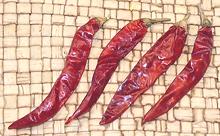 [Tree Chili; Rat Tail Chili; C. annuum]
[Tree Chili; Rat Tail Chili; C. annuum]
This is NOT a Southeast Asian Chili, at least not yet. It is included here
because is is widely available in North America and works well in Southeast
Asian and Indian recipes. Their hotness falls conveniently between the Japones
and dry red Thai Chilis at a high H7,
and they have good flavor, especially when toasted. They are 2 to 5 inches
long and easily recognized from their long, slender, sharply pointed shape.
They are mostly grown in Mexico.
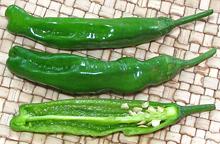 [C. annuum]
[C. annuum]
This chili, common here in Southern California, is included on this page
because one of my Burmese cookbooks has a photo labeled "Mild Green Chilis".
Those chilis looked exactly like Shishitos except much shorter, like the
Spanish Padróne, from which both are probably descended. They have
almost no heat, except about 1 in 20 can surprise. Burma has common borders
with both Thailand and Laos, so chilis like these may also be seen in those
countries. The longest chili in the batch from which the photo specimens
were drawn was 4-1/4 inches, not counting stems. For details see our
Padrón & Shishito
page.
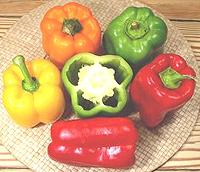 [Nga yohk kaung (Burma); C. annuum var. grossum]
[Nga yohk kaung (Burma); C. annuum var. grossum]
These are regular red, green and yellow bell peppers. Yes, they use them
in Thailand, but not to nearly the extent they are used in China. Their
hotness is H0, though
occassionally one will show a trace of heat.
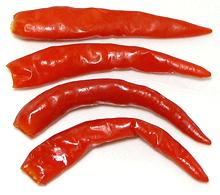
These chilis are called out mostly for the cuisines of Sichuan and
Hunan China, but those available here in California are invariably
packed in Thailand. I presume the Thais also use them. They may be
pickled Japones, moderately hot, around
H4-H5, and are from 2 to 2-1/2 inches long. Ingred: Red Chili,
Water, Salt, Citric Acid, Sodium Benzoate, Calcium Chloride, Sodium
Metabisulfite.
 [Dutch Red, Cabai Merah (Indonesia); C. annuum]
[Dutch Red, Cabai Merah (Indonesia); C. annuum]
These are popular in Holland and its former colonies in Indonesia as well
as other parts of Europe and North America. A cayenne type pepper sold
fresh and red ripe, 4 to 6 inches long by 5/8 inch diameter and tapered
to a sharp point, they are medium hot
(H4-5). They have thicker flesh than some long narrow chilis
and sweet taste. They Probably would be about right for Sichuan and
Hunan recipes, and are a good choice for most ethnic cuisines. The much
more available Red Fresnos are a good
substitute, though of different shape and thicker walled.
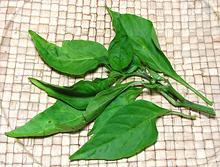 [Chili Leaf; Bai Prik (Thai); Bai Mak Pet (Laos); Dahon ng Sili
(Philippine)]
[Chili Leaf; Bai Prik (Thai); Bai Mak Pet (Laos); Dahon ng Sili
(Philippine)]
What variety of chili plant these come from is not very important as
they have no heat and little flavor. They are used mostly for color,
particularly in Thai Green Curry Paste, to make it bright green without
using so many green chilis it is too hot. In Laos They are used in soups
and stews, and similarly in the Philippines. I have most often found
them in Philippine markets, but I also get them from my own chili plants.